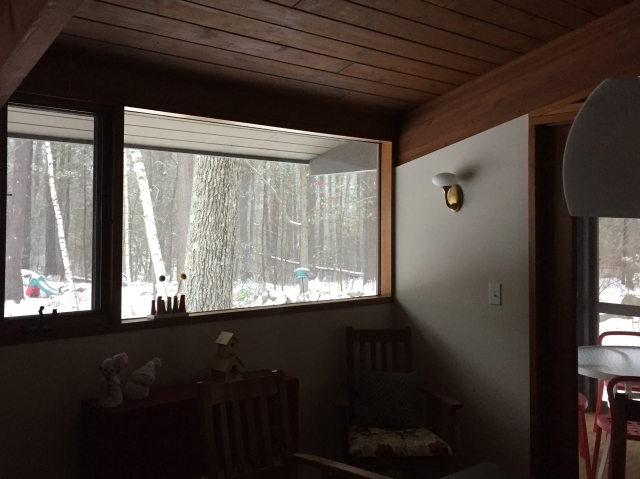Last night was the winter solstice, the longest night of the year. For me this is a somber time. Candles and bonfires burned at the Yule celebration in my town where we sang and recited poems and hoped for the future together. Deep inside we connect with each other in our common need to push back the dark, as have many past generations. Dark is bad, light is good. I remind myself to reserve judgement, because as death is part of life, light cannot exist without the dark. One makes the other more beautiful. We can only appreciate the sun in contrast to where it is not. Architects, someone once said, build complex forms to better hold the emptiness. Music serves to bracket the silence. At this time of year it is important to appreciate shadow.
In Praise of Shadows is an essay written by Jun’ichiro Tanizaki in 1933 and was translated into English 44 years later by Thomas J Harper. It is my December scripture. The author mourns the loss of time-honored Japanese customs to Western modernization after the Meiji Restoration. He records what it means to him to be Japanese: the warmth of wood and softness of paper, the murky quality of jade and the patina of well loved tin instead of glass, white tile, and chrome. Dining by candle light, he noticed “as I gazed at the trays and bowls standing in the shadows cast by that flickering point of flame, I discovered in the gloss of this lacquerware a depth and richness like that of a still dark pond, a beauty I had not before seen.” Gold decoration on lacquerware draws the light to it and also acts as a reflector. My favorite verse is about Japanese domestic architecture:
In making for ourselves a place to live, we first spread a parasol to throw a shadow on the earth, and in the pale light of the shadow we put together a house… And so it has come to be that the beauty of a Japanese room depends on a variation of shadows, heavy shadows against light shadows – it has nothing else. Westerners are amazed at the simplicity of Japanese rooms, perceiving in them no more than ashen walls bereft of ornament. Their reaction is understandable, but it betrays a failure to comprehend the mystery of shadows. Out beyond the sitting room, which the rays of the sun can at best but barely reach, we extend the eaves or build on a veranda, putting the sunlight at still greater a remove. The light from the garden steals in but dimly through paper-paneled doors, and it is precisely this indirect light that makes for us the charm of a room. We do our walls in neutral colors so that the sad, fragile, dying rays can sink into absolute repose…. We delight in the mere sight of the delicate glow of fading rays clinging to the surface of a dusky wall, there to live out what little life remains to them. We never tire of the sight, for to us this pale glow and these dim shadows far surpass any ornament.
What a wonderful opportunity to give depth to the shadows! In the shadows there is pattern, subtlety, tranquility and reflection. The dim light allows our other senses to tell us what we may not have noticed otherwise. We become aware of where there is carelessness or waste when we must reserve our energy for keeping warm and using just what we need. We take time to appreciate those we love, what we have and the beauty of nature.
Now it is silently snowing outside. The gray sky and white ground are connected by countless tree trunks which tilt slightly this way and that. My home becomes a warm cave from which I can rest and observe the changing seasons. When the seasons do change I will run outside and absorb the warm sun. But eventually, I always look forward to the return of the shadows.
Eve Isenberg is an Architect, wife, mom of three daughters, and much older than her mugshot. She lives in Concord, MA.
Sample Block Quote
Praesent vestibulum congue tellus at fringilla. Curabitur vitae semper sem, eu convallis est. Cras felis nunc commodo eu convallis vitae interdum non nisl. Maecenas ac est sit amet augue pharetra convallis.
Sample Paragraph Text
Praesent vestibulum congue tellus at fringilla. Curabitur vitae semper sem, eu convallis est. Cras felis nunc commodo eu convallis vitae interdum non nisl. Maecenas ac est sit amet augue pharetra convallis nec danos dui. Cras suscipit quam et turpis eleifend vitae malesuada magna congue. Damus id ullamcorper neque. Sed vitae mi a mi pretium aliquet ac sed elitos. Pellentesque nulla eros accumsan quis justo at tincidunt lobortis deli denimes, suspendisse vestibulum lectus in lectus volutpate.






